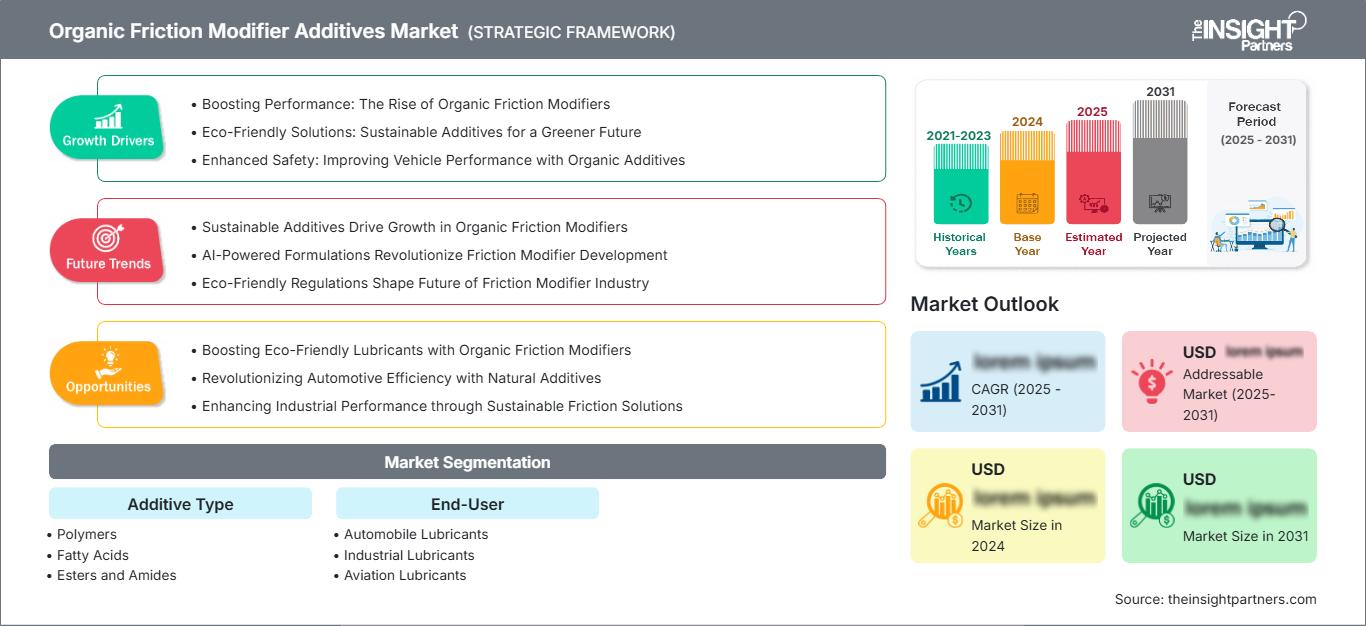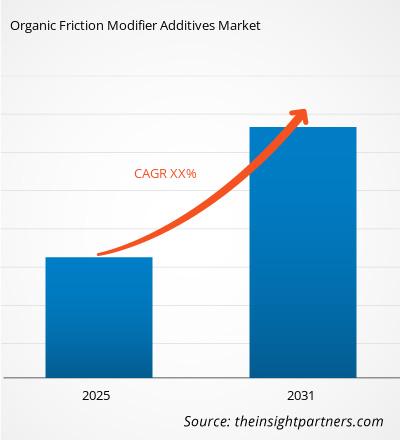有機摩擦調整剤市場は、2026年から2034年にかけて着実な成長を記録すると予想されており、その評価額は2025年の基準値から増加し、予測期間の終了まで持続的な拡大を続けると予測されています。この傾向は、進化する業界要件と継続的な技術進歩に牽引された、好ましい市場見通しを反映しています。
本レポートは、添加剤の種類(ポリマー、脂肪酸、エステル、アミド)別に分類され、さらにエンドユーザー(自動車用潤滑油、工業用潤滑油、航空用潤滑油、エネルギー/発電用潤滑油、鉄道用潤滑油)に基づいて市場を分析しています。これらの主要セグメントごとに、世界、地域、国レベルで包括的な内訳が提供されています。レポートには、すべてのセグメントの市場規模と予測が含まれており、値は米ドルで表示されています。また、主要企業の現在の市場状況に関する重要な統計情報とともに、一般的な市場動向と新たな機会に関する洞察も提供します。
レポートの目的
The Insight Partners によるレポート「有機摩擦改質添加剤市場」は、現在の状況と将来の成長、主な推進要因、課題、機会について説明することを目的としています。これは、次のようなさまざまなビジネス関係者に洞察を提供します。
- 技術プロバイダー/メーカー: 進化する市場動向を理解し、潜在的な成長機会を把握することで、情報に基づいた戦略的決定を下すことができます。
- 投資家: 市場の成長率、市場の財務予測、バリュー チェーン全体に存在する機会に関する包括的なトレンド分析を実施します。
- 規制機関: 市場の乱用を最小限に抑え、投資家の信頼と信用を維持し、市場の完全性と安定性を維持することを目的として、市場における政策と警察活動を規制します。
有機摩擦調整剤市場セグメンテーション 添加剤タイプ
- ポリマー
- 脂肪酸
- エステルおよびアミド
エンドユーザー
- 自動車用潤滑油
- 工業用潤滑油
- 航空用潤滑油
- エネルギー/発電用潤滑油
- 鉄道用潤滑油
レポートの一部、国レベルの分析、Excelデータパックなどを含め、スタートアップ&大学向けに特別オファーや割引もご利用いただけます(無償)
有機摩擦調整剤市場: 戦略的洞察

-
このレポートの主要な市場動向を入手してください。この無料サンプルには、市場動向から見積もりや予測に至るまでのデータ分析が含まれます。
有機摩擦調整剤市場の成長ドライバー
- パフォーマンスの向上:有機摩擦調整剤の台頭
- 環境に優しいソリューション:より環境に優しい未来のための持続可能な添加剤
- 安全性の向上:有機添加剤による車両性能の向上
有機摩擦調整剤市場の今後の動向
- 持続可能な添加剤が有機摩擦調整剤の成長を促進
- AIを活用した配合が摩擦調整剤開発に革命をもたらす
- 環境に優しい規制が摩擦調整剤業界の未来を形作る
有機摩擦調整剤市場の機会
- 有機摩擦による環境に優しい潤滑剤の促進改質剤
- 天然添加剤による自動車効率の革新
- 持続可能な摩擦ソリューションによる産業パフォーマンスの向上
有機摩擦調整剤市場
予測期間全体を通して有機摩擦調整剤市場に影響を与える地域的な傾向と要因は、The Insight Partnersのアナリストによって徹底的に説明されています。このセクションでは、北米、ヨーロッパ、アジア太平洋、中東・アフリカ、中南米における心不整脈疾患管理市場のセグメントと地域についても説明します。
有機摩擦改質添加剤市場レポートの範囲
| レポート属性 | 詳細 |
|---|---|
| の市場規模 2025 | US$ XX Million |
| 市場規模別 2034 | US$ XX Million |
| 世界的なCAGR (2026 - 2034) | XX% |
| 過去データ | 2021-2024 |
| 予測期間 | 2026-2034 |
| 対象セグメント |
By 添加剤の種類(ポリマー,脂肪酸,エステル,アミド,その他)By エンドユーザー(自動車用潤滑油,工業用潤滑油,航空用潤滑油,エネルギー/発電用潤滑油,鉄道用潤滑油)By 地理
|
| 対象地域と国 |
北米(米国,カナダ,メキシコ)
|
| 市場リーダーと主要企業の概要 |
|
有機摩擦改質添加剤市場のプレーヤー密度:ビジネスダイナミクスへの影響を理解する
有機摩擦調整剤市場は、消費者の嗜好の変化、技術の進歩、製品メリットへの認知度の向上といった要因によるエンドユーザーの需要増加に牽引され、急速に成長しています。需要の増加に伴い、企業は製品ラインナップの拡充、消費者ニーズへの対応のための革新、そして新たなトレンドの活用を進めており、これが市場の成長をさらに加速させています。

- 入手 有機摩擦調整剤市場 主要プレーヤーの概要
主なセールスポイント
- 包括的な調査範囲:本レポートは、有機摩擦改質添加剤市場における製品、サービス、種類、エンドユーザーの分析を包括的に網羅し、包括的な展望を提供しています。
- 専門家による分析:本レポートは、業界の専門家とアナリストの深い理解に基づいて作成されています。
- 最新情報:本レポートは、最新の情報とデータ動向を網羅しているため、ビジネスの関連性を保証します。
- カスタマイズオプション:本レポートは、特定のクライアントの要件に対応し、ビジネス戦略に適切に適合するようにカスタマイズできます。
したがって、有機摩擦改質添加剤市場に関する調査レポートは、業界のシナリオと成長見通しを解読し理解するための先導役となります。いくつかの妥当な懸念事項があるかもしれませんが、本レポートの全体的なメリットは、デメリットを上回る傾向があります。
- 過去2年間の分析、基準年、CAGRによる予測(7年間)
- PEST分析とSWOT分析
- 市場規模価値/数量 - 世界、地域、国
- 業界と競争環境
- Excel データセット
最新レポート
関連レポート
お客様の声
購入理由
- 情報に基づいた意思決定
- 市場動向の理解
- 競合分析
- 顧客インサイト
- 市場予測
- リスク軽減
- 戦略計画
- 投資の正当性
- 新興市場の特定
- マーケティング戦略の強化
- 業務効率の向上
- 規制動向への対応






















 無料サンプルを入手 - 有機摩擦調整剤市場
無料サンプルを入手 - 有機摩擦調整剤市場